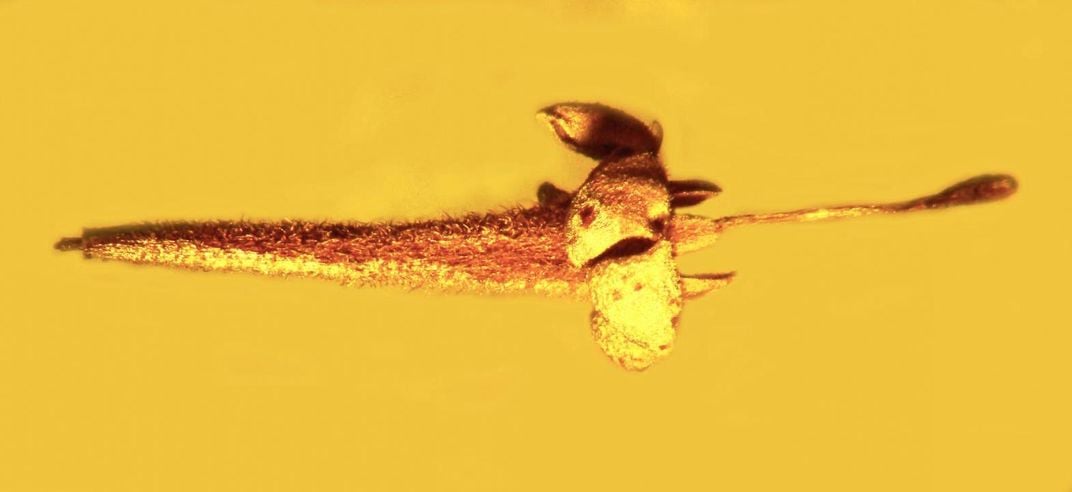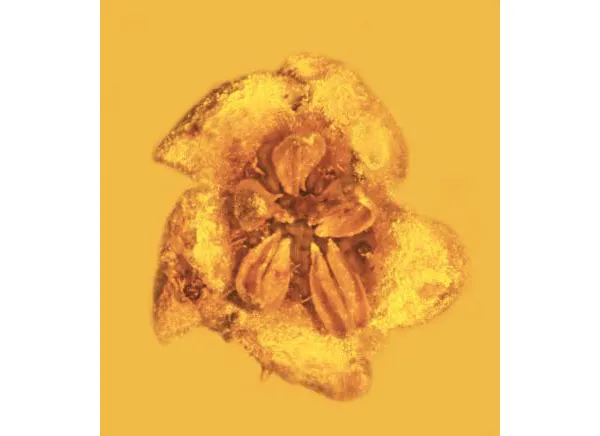New Species of Prehistoric Flower Discovered Preserved in Amber
Rare fossil may be an ancient relative of the potato
:focal(651x344:652x345)/https://tf-cmsv2-smithsonianmag-media.s3.amazonaws.com/filer/1d/1b/1d1bd5df-2ba2-4de7-b77a-986942045213/108835_web.jpg)
The delicate structures of flowers rarely fossilize, but the sticky resin of trees can capture these dainty specimen, preserving them for tens of millions of years. Scientists recently found two of such fossils, which turned out to be a new species that may have been a poisonous predecessor to modern plants like coffee and potato.
Scientists discovered the pair of rare fossil flowers in a mine in the Dominican Republic, according to a new study published this week in the journal Nature Plants. Dubbed Strychnos electri, these tiny beauties belong to a group of flowers called asterids, which includes such varied members as coffee, potatoes, peppers, sunflowers, and the poisonous strychnine tree, Annalee Newitz writes for Ars Technica.
"The specimens are beautiful, perfectly preserved fossil flowers, which at one point in time were born by plants that lived in a steamy tropical forest with both large and small trees, climbing vines, palms, grasses and other vegetation," study author and Oregon State University researcher George Poinar, Jr. said in a statement.

The two flowers are very tiny, about a centimeter long apiece. But while Poinar and his colleagues know the plants are somewhere in the ballpark of tens of millions of years old, they are still not clear on exactly how old they are, Mary Beth Griggs writes for Popular Science. While researchers can date fossils preserved in rock by analyzing where it was found and the radioactive decay of certain elements contained in the rocks around them, amber is harder to to date because it is made from fossilized tree resin.
In order to figure out how old these fossilized flowers were, Poinar had to rely on other life forms found alongside the amber-encased specimens, particularly a couple of common single-celled organisms called foraminifera and coccoliths. Because the evolutionary paths of these tiny animals are distinctive and well-known, scientists often used them to date fossil specimens by proxy, Newitz writes.
However, in this case the tests were somewhat inconclusive: each test gave different results, suggesting that the flowers were fossilized anywhere between as early as 45 million years ago and as recently as 15 million years ago.

Poinar may not know exactly how long ago Strychnos electri thrived, but it’s possible it was somewhat poisonous.
"Species of the genus Strychnos are almost all toxic in some way," Poinar said. "Some are more toxic than others, and it may be that they were successful because their poisons offered some defense against herbivores.”
Today, there are about 200 species of Strychnos plants, some of which are the sources of some of the world’s deadliest poisons, like strychnine and curare. It’s impossible to know if or how poisonous Strychnos electri was, but Poinar hopes this discovery will help shed new light on what the America’s forests were like millions of years ago, long before North and South America were joined by a land bridge, Newitz writes.
"Specimens such as this are what give us insights into the ecology of ecosystems in the distant past," Poinar said in a statement. "It shows that the asterids, which later gave humans all types of foods and other products, were already evolving many millions of years ago."